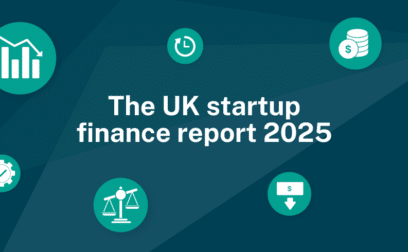TABLE OF CONTENTS
Page written by Chris Godfrey. Last reviewed on December 9, 2025. Next review due April 6, 2027.

Many businesses go through periods when cash is tight. Some companies have fluctuating sales cycles that make this problem a regular occurrence. But no matter if this issue is a one-off event or a frequent situation, the lack of working capital to fund everyday operations and spur growth is not good for any type of business. Fortunately, there’s a solution to short-term financial stress – meet the working capital loan – quick, simple, flexible, it’s the easiest way to keep your business running at full speed.
Working capital – also known as ‘net working capital’, or ‘NWC’ – is the difference between a company’s current assets and its current liabilities and it is a measure of a business’s liquidity and short-term financial health. Current assets include items such as cash, accounts receivable, and inventories of raw materials and finished goods. Current liabilities include things like accounts payable and debts.
Positive working capital is where assets are worth more than liabilities. This usually means there is good liquidity and enough cash to fund ongoing activities and invest in growth. Negative working capital, where liabilities are greater than assets and there is no surplus cash, indicates poor liquidity and it may be viewed as sign that the company is unable to adequately fund its daily activities or may even be facing bankruptcy.

A word from Andrea
"Working capital loans are the easiest way to ensure your business has the funds for day-to-day operations and business growth. This type of loan is available as a fixed term loan, or a short term facility to bridge the gap until your business receives payment from your customers."
Working capital is calculated by subtracting the total of a company’s liabilities from its total current assets. Current assets include cash, accounts receivable, inventory, and other assets that are expected to be liquidated or turned into cash in less than one year. Current liabilities include accounts payable, wages, taxes payable, and the current portion of long-term debt that’s due within one year. If the result reveals a surplus of assets, that is called positive working capital. If the result reveals more liabilities than assets, that’s called negative working capital.
Example:
Company’s total current assets: £200,000
Less :
Company’s total current liabilities : £135,000
Result :
Positive working capital of £65,000
Working capital efficiency is a measure of how fast a business can convert inventories or available services into sales, compared to how soon it must pay its suppliers for those same inventories or services. This is also known as the cash conversion cycle. The sooner a company can make a sale, compared to the time it must pay for the item or service it is selling, the better its working capital efficiency. Cash that is tied up for too long in warehoused inventory or pre-paid services, reveals poor working capital efficiency. Businesses with good working capital efficiency can usually borrow more easily from lenders and allocate more cash to invest in growth.
Example:
Company buys inventory on 60 days credit from suppliers.
It sells the inventory in an average of 30 days from delivery by supplier.
Result:
Good working capital efficiency.
Company buys inventory on 60 days credit from suppliers.
It sells the inventory in an average of 90 days from delivery by supplier.
Result:
Poor working capital efficiency.
Working capital loans provide cash to fund a company’s day to day operating expenses. They are short-term debt instruments and not used for long-term debt or investments such as the purchase of plant or property. Working capital loans are typically paid back within a year or less and they are useful because many businesses have income that varies throughout the year. This is especially true of businesses that sell seasonal goods or services, where they have brief periods of high sales and prolonged periods when sales are slow. Because many costs, such as wages, rent, utilities, and materials or inventory purchases remain constant, businesses with fluctuating sales cycles often need a working capital loan to cover these expenses during their quieter sales periods.
Working capital loans provide cash to fund a business’s everyday activities and pay for things like wages, rent, utilities, materials, inventory, and ancillary services. Loans can either be secured or unsecured and are usually paid back within one year or less. Secured loans are typically easier to obtain, as the borrower provides collateral to protect the lender from loss. Unsecured loans are obtained without the provision of collateral and are based on the credit score and financial health of the company and sometimes, of the business owner(s).
UK working capital loans come in a variety of shapes and sizes and they include term loans, business lines of credit, business credit cards, merchant cash advances, and invoice financing.
Working capital loans from £5k all the way to £25m are available, but your borrowing ability will be determined by several factors, such as gross turnover, how long your business has been trading, your business credit score, the type of industry you operate in, what type of borrowing you choose, and if the loan is secured or unsecured. Register with Swoop to discuss your borrowing needs and to determine what type of loan works best for your business.
Working capital loans are used to pay for general business costs. This means they can be used for almost anything to help your business thrive. Typically used during periods when income is reduced but costs remain constant or even elevated, working capital loans can cover wages, rent, taxes, utility costs, repairs, inventory build-up, materials purchases, marketing expenses and more.
Interest rates vary according to the type of working capital loan you choose and if it is secured or unsecured. (Secured loans usually come with lower interest rates and fees). Current rates range from 9.9% representative APR for business credit cards, anywhere from 1.8% – 45% with term loans, and as low as 0.6% if you opt for invoice financing.
Company A are a wholesaler. They sell seasonal goods for the holiday period at the end of the year. From March onwards, they buy finished goods from manufacturers across the globe and during the summer months, they re-sell these goods to large retailers nationwide. Peak sales occur during July to September and they receive payment in November and December. Their busiest period is in the spring and summer when they must make large payments to suppliers for finished goods and their onward shipping to customers.
Because the company’s income is ‘lumpy’, with lengthy periods of cash going out but little coming in, they typically rely on a working capital loan to pay regular expenses and the costs of buying stock during the slow sales period. They do this by withdrawing cash from a business line of credit, using borrowed funds to cover costs until the bulk of their income arrives in the last two months of the year. As they receive payment from their customers, the company repays the line of credit, plus any interest charges and fees. By the time the cycle starts again each March, they have returned the line of credit balance to zero.
Use our simple loans calculator to find out how much you may be able to borrow and what your loan may cost in fees and interest charges.
Your loan details
This calculator is intended for illustration purposes only and exact payment terms should be agreed with a lender before taking out a loan.
Your results
Monthly payments
£0
Weekly payments
£0
Daily payments
£0
Avg. monthly interest
£0
Total interest
£0
Total cost of finance
£0
Borrow £
Pros
Working capital is crucial for business growth, but almost every business goes through periods when available working capital is tight, (but the bills must still be paid). A working capital loan can smooth away the bumps in a company’s cash flow, giving the business the best chance of success.
Key advantages of a working capital loan:

Cons
Compared to the upsides, there are few disadvantages to working capital loans:
A term loan is a lump sum of borrowed cash that is paid back with regular payments over a fixed period. Technically, this is a working capital loan. However, because the loan is not flexible, (after receipt of the initial lump sum, the borrower cannot re-borrow the same cash again and again like a line of credit), some lenders and borrowers class term loans differently. Additionally, most working capital loans are short-term, usually repaying in a year or less, whereas term loans can be repaid over much longer periods – anywhere from one to thirty years.
At first glance, working capital loans and bank overdraft facilities would appear to be the same thing – they both provide extra funds when needed. However, many working capital loans have a final repayment date when the borrowed funds must all be repaid – whereas bank overdrafts can usually be refreshed annually and stay in place for years. Additionally, unlike working capital loans that can often be obtained quickly, bank overdrafts are typically slow to set up and can come with punitive penalty charges should the borrower exceed their credit limit. Both types of loan may require the borrower to provide collateral as security.
Cash credit is a bank lending facility that functions like an overdraft – it provides extra funds when the business needs it. However, unlike an overdraft, which is essentially an open agreement between the bank and the customer to let the customer’s bank account run into the negative, cash credit is a separate account – sometimes called a ‘cash reserve account’ – that can provide emergency funds upon demand. (The customer ‘calls’ funds from the cash credit account and they are transferred to the customer current account). Cash credit accounts differ from most other working capital loans because they often require collateral from the borrower, have no fixed repayment date and interest is usually charged daily.
Yes. There are working capital loans for all type of business and with good credit or bad. Even if you’ve been turned down elsewhere, it may still be possible to obtain the financing your business needs to succeed. Register with us to discover more about our working capital loans for businesses with bad credit or even no credit at all.
Yes. There are specialist working capital loans for startups, and an array of borrowing options for small businesses and sole traders. No matter what type of industry you operate in, if you’re just beginning your entrepreneurial journey, or your small business has decades behind it, there’s a working capital loan to suit your needs.
Working capital loans can be obtained with or without providing collateral. Some loan products, such as business credit cards, can usually be obtained unsecured, others, such as merchant cash advances, have security built-in as they are based on the borrower’s customer credit card transactions. Business lines of credit and term loans may or may not require collateral. Your company’s financial history, the amount you wish to borrow and the type of loan you choose will determine if security is required or not.
Unlike long-term asset-purchase loans, such as business mortgages, working capital loans are designed to fund short-term dips in a business’s available cash. As debt, they create a liability on the balance sheet, but as cash they also create an asset on the ledger. Even as the borrowed sum is spent to pay ongoing business activities this equality remains the same – the cash on the asset side of the ledger may be reducing, but so are the debts on the liability side that the cash is paying off. This means working capital loans are neither a true asset, nor a true liability. They are a self-cancelling payment mechanism.
A working capital demand loan is like a bank overdraft or a business line of credit; the company opens a flexible loan account and has the freedom to withdraw and repay funds into the account as required. However, unlike bank overdraft facilities or business lines of credit, which may continually refresh and remain in place for years, a demand loan will have a fixed repayment date when the borrowing must be repaid in full – typically 90 or 180 days. Working capital demand loans can usually be obtained quickly and they may or may not require collateral.
For Paypal business users only. Credit approval, the amount that can be borrowed and the repayment terms are determined by the borrower’s Paypal sales and account history. No other documentation is required. The borrower’s personal credit score is unaffected.
For eBay sellers only. Credit approval, the amount that can be borrowed and the repayment terms are determined by the borrower’s Ebay sales and account history, plus other financial and business information.
The documentation required to obtain a working capital loan will vary according to the amount you wish to borrow and the type of business you operate. Some of the more routinely required documents include:
The type of loan you are seeking will also have impact on the documentation you must supply – for example, a merchant cash advance will require different paperwork than a business line of credit. Lastly, lenders will conduct a credit check on your business and possibly the business owner(s).
No matter if your business is a startup or an established SME, or if it operates in retail, manufacturing, construction, automotive, farming, transport, or a myriad of other industries, it is almost certainly eligible for a working capital loan. Additionally, organisations with seasonal sales periods or that offer extended credit to their customers are ideally situated for this type of financial support. Register with Swoop to discover what type of working capital loan your business is best qualified for.
If you need immediate cash to buy inventory, pay wages, cover tax bills, make repairs or expand your business, a working capital loan can make the going easier. Get started with one simple application. Give your business the business credit it deserves. Apply now.
Written by
Chris is a freelance copywriter and content creator. He has been active in the marketing, advertising, and publishing industries for more than twenty-five years. Writing for Barclays Bank, Metro Bank, Wells Fargo, ABN Amro, Quidco, Legal and General, Inshur Zego, AIG, Met Life, State Farm, Direct Line, insurers and pension funds, his words have appeared online and in print to inform, entertain and explain the complex world of consumer and business finance and insurance.
Swoop promise
At Swoop we want to make it easy for SMEs to understand the sometimes overwhelming world of business finance and insurance. Our goal is simple – to distill complex topics, unravel jargon, offer transparent and impartial information, and empower businesses to make smart financial decisions with confidence.
Find out more about Swoop’s editorial principles by reading our editorial policy.
Related pages
Get your free Working capital loans quote today
Join the 110,000+ businesses just like yours getting the Swoop newsletter.
Free. No spam. Opt out whenever you like.



























We work with world class partners to help us support businesses with finance
Kingfisher Way, Silverlink Business Park, Newcastle upon Tyne, NE28 9NX, UK
View in Google MapsAberystwyth Innovation and Enterprise Campus
Gogerddan Campus
Aberystwyth University
Ceredigion
SY23 3EE
Dogpatch Labs, The CHQ Building, Custom House Quay, Dublin, Ireland
View in Google MapsSuite 801, Level 8, 84 Pitt Street, Sydney, NSW 2000, Australia
View in Google Maps43 W 23rd St, New York, NY 10010, United States
View in Google Maps21 Dreyer Street, Cape Town, South Africa, 7708
View in Google Maps
Disclaimer: Swoop Finance helps UK firms access business finance, working directly with businesses and their trusted advisors. We are a credit broker and do not provide loans or other finance products ourselves. We can introduce you to a panel of lenders, equity funds and grant agencies. Whichever lender you choose we may receive commission from them (either a fixed fee of fixed % of the amount you receive) and different lenders pay different rates. For certain lenders, we do have influence over the interest rate, and this can impact the amount you pay under the agreement. All finance and quotes are subject to status and income. Applicants must be aged 18 and over and terms and conditions apply. Guarantees and Indemnities may be required. Swoop Finance can introduce applicants to a number of providers based on the applicants’ circumstances and creditworthiness. Swoop Finance Limited is registered with the Financial Conduct Authority as an Account Information Services Provider (reference number 833145). Swoop Finance Limited is authorised as a credit broker under FCA registration number 936513. If you feel you have a complaint, please read our complaints section highlighted above and also contained within our terms and conditions. Swoop Finance Ltd is registered with Companies House (company number 11163382, registered address The Stable Yard, Vicarage Road, Stony Stratford, Milton Keynes MK11 1BN). VAT number: 300080279
Clever finance tips and the latest news
Delivered to your inbox monthly
Join the 110,000+ businesses just like yours getting the Swoop newsletter. Free. No spam. Opt out whenever you like.
Thanks for requesting a call back
a member of the team will be in touch.




